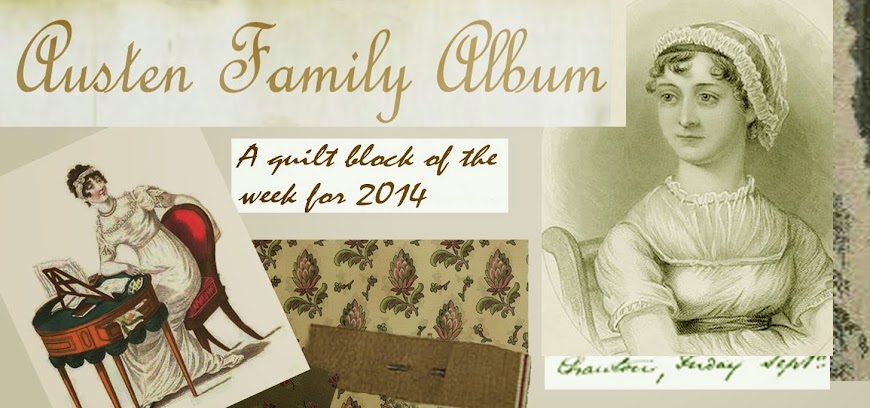Block 6: Empire Star
for the French Emperor Napoleon Bonaparte
by Becky Brown
Jane Austen lived in a cold climate of English/French wars from the time she was about 17 until the end of her thirties. Hostilities began during the French Revolution and accelerated as Napoleon Bonaparte rose from Army officer to self-declared Emperor of Europe.
Napoleon Bonaparte
1769-1821
James Gillray: The First Kiss in Ten Years
Above, England embraces Napoleon to sign the Treaty of Amiens in 1802, a shaky peace lasting only two years when Jane was in her late twenties. This small window afforded English travelers a rare chance to visit France.
James Gillray: Pitt of England and Bonaparte of
France carving up the globe.
The French wars gave work to her
brothers, two in the Navy, one in the Army, and made a widow of her cousin Eliza and a spinster of her sister Cassandra.
The Bennet girls meet Lt. Wickham in Pride & Prejudice,
illustration by H. W. Brock, 1895
Jane doesn't really refer to the wars in her novels but her characters and readers took that social context for granted. Trade was disrupted, taxes increased and soldiers were stationed all over England.
By 1808 Napoleon claimed most of Europe---the territory
pictured in yellow above. The British Isles in pink
(top left) considered themselves the last fortress of resistance
against a madman's ambition.
Napoleon's France was only 20 miles across the English Channel from Dover in Kent. Jane's brother Edward's family lived at Godmersham in Kent (the arrow on the right), where French threats of sea invasion kept the populace anxious for years. During the latter years of the Napoleonic Wars Jane lived at Chawton (the left arrow), not much farther from Boney's invaders. The British Navy kept Napoleon from carrying out any actual landings in England, much to the Austen family's pride and relief.
A world map from the Wikipedia
The green areas show the First French Empire and its allies (note the green U.S. during what we call the War of 1812). Blue areas represent the Coalition against Napoleon.
Empire Star by Becky Brown
Empire Star was given the name by Hearth & Home magazine in the first decades of the 20th century. It's a good block to remember Napoleon and the French wars, actually the first World War.
BlockBase #3222
Cutting a 12" Finished Block
A - Cut 2 squares 3-78" x 3-7/8". Cut each in half diagonally to make 2 triangles.
You need 4 triangles.
B - Cut 2 squares 7-1/4" x 7-1/4" of different colors. Cut with 2 diagonal cuts to make 4 triangles.
You need 8 triangles.
C - You need 4 parallelograms, 2 going one way and 2 flipped over. Cut 4 rectangles 2-5/8" x 7-5/8".
Trim to 45 degree angles. Trim 2 going one direction and 2 the other.
The rectangle should be 7-5/8" long before trimming.
And you could trim after sewing the first step below.
And you could trim after sewing the first step below.
D - Cut 1 square 4-3/4" x 4-3/4".
Sewing:
UPDATE: Here's Dustin's block in Dupioni silks
Napoleon as Gulliver and King George III
as the King of Brobdingnag.
Napoleon finally surrendered in 1815 when Jane was about 40.
#6 by Bettina Havig
Have you ever noticed that NOBODY around here follows the pattern?
Bettina has changed the composition.
But I know how to Photoshop.
Empire Star by Bettina Havig
This week's culprit.






















Didn't they remember that your the designer? Lol I think we all get used to tweaking patterns to make them our own . That Artistic license. I'm loving this and I've never donea BOM or BOW and iI've been quilting for 15 years. But I don't usually fallow patterns very well. Your design and history and really a joy. Thank you
ReplyDeleteWelcome to the club of people with artistic license.
ReplyDelete